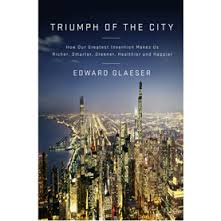You Can’t Keep Them Down On The Farm – Glaeser’s Triumph of the City
 Edward Glaeser, Harvard economist and prolific blogger, is enraptured with cities. His 2011 book, Triumph of the City, is a paean to all things urban, with a special place for the twenty-first century mega-city. The work is a breezy airport read. Informative and lightly pedantic, it is a departure for Glaeser, who is a well-respected economic researcher. It is a work well suited for what we used to call the middlebrow market.
Edward Glaeser, Harvard economist and prolific blogger, is enraptured with cities. His 2011 book, Triumph of the City, is a paean to all things urban, with a special place for the twenty-first century mega-city. The work is a breezy airport read. Informative and lightly pedantic, it is a departure for Glaeser, who is a well-respected economic researcher. It is a work well suited for what we used to call the middlebrow market.
Triumph jets around the globe, zooming in on this city or that from 35,000 feet . There is little to no original scholarship here. Instead, Glaeser has skillfully assembled a host of anecdotes and a panoply of data points to argue that cities are good for people and the planet. His narrative rests on his observations and insights. He is smart, well-informed, and confident in his prose. The argument driving the book is summarized neatly in the subtitle: “How our greatest invention makes us richer, smarter, greener, healthier, and happier.”
Cities, Glaeser claims, are magnets for smart human talent. As they create opportunities, they and their inhabitants flourish. Density promotes competition and competition forces innovation. Glaeser promotes ever greater density here. He criticizes mindless historic preservation as an impediment to urban success with a nod to Jane Jacobs. The narrative presents pros and cons of various urban policies, but is distant from the human politics that create the cities and decide those policies.
For all of Glaeser’s urban enthusiasm, the book has an oddly antiseptic feel to it. Some is due to the author’s relative lack of interest in people as individuals. He is, after all, a social scientist. The deeper reason is that Glaeser’s argument is fundamentally about the relative benefit of cities to society; it is not about the joy of living in a city or in a particular city. This is not an issue of class, integrity, or design. I share Glaeser’s affirmation of high-density mixed use, though I am less keen on the high-rise. Nor is it about crime or grit. Missing is a sense of the flavors that go with city life.
A certain kind of urban aesthetics about how one leads one’s life necessarily must inform writing about cities. For all of Glaeser’s intellectual enthusiasm, his book does not carry much personal passion for city life. The tensions, interactions, and felicity that accompany the forced socialization that accompanies being squeezed together in a city do not complicate this work. Glaeser does not strike this reader as in love with cities, though he certainly does wax warmly for New York. But I see him in a high-rise condo, perhaps on the upper East Side. It is difficult to picture him in a walk-up in Brooklyn or Queens. It came as no surprise to learn that he now lives in the suburbs with his family and children.
I guess my aesthetic is just different – another good reason cities are a great place to live.
David Potash